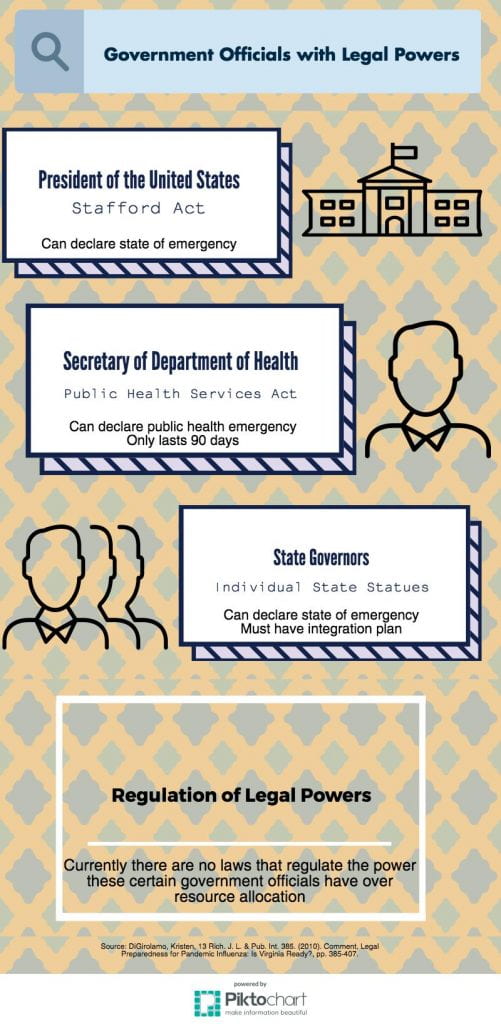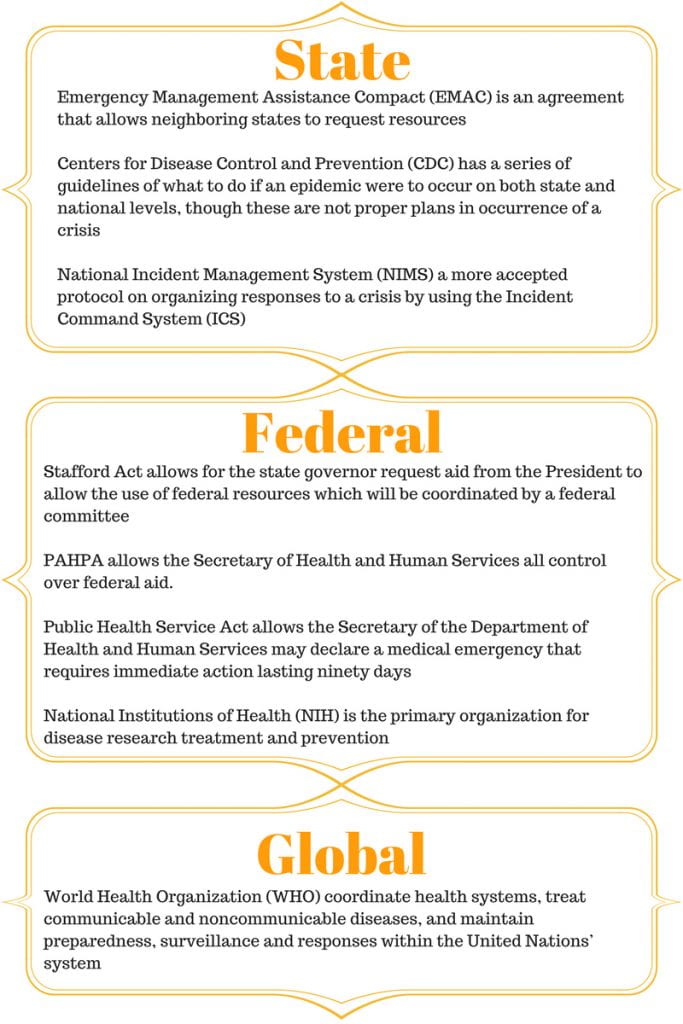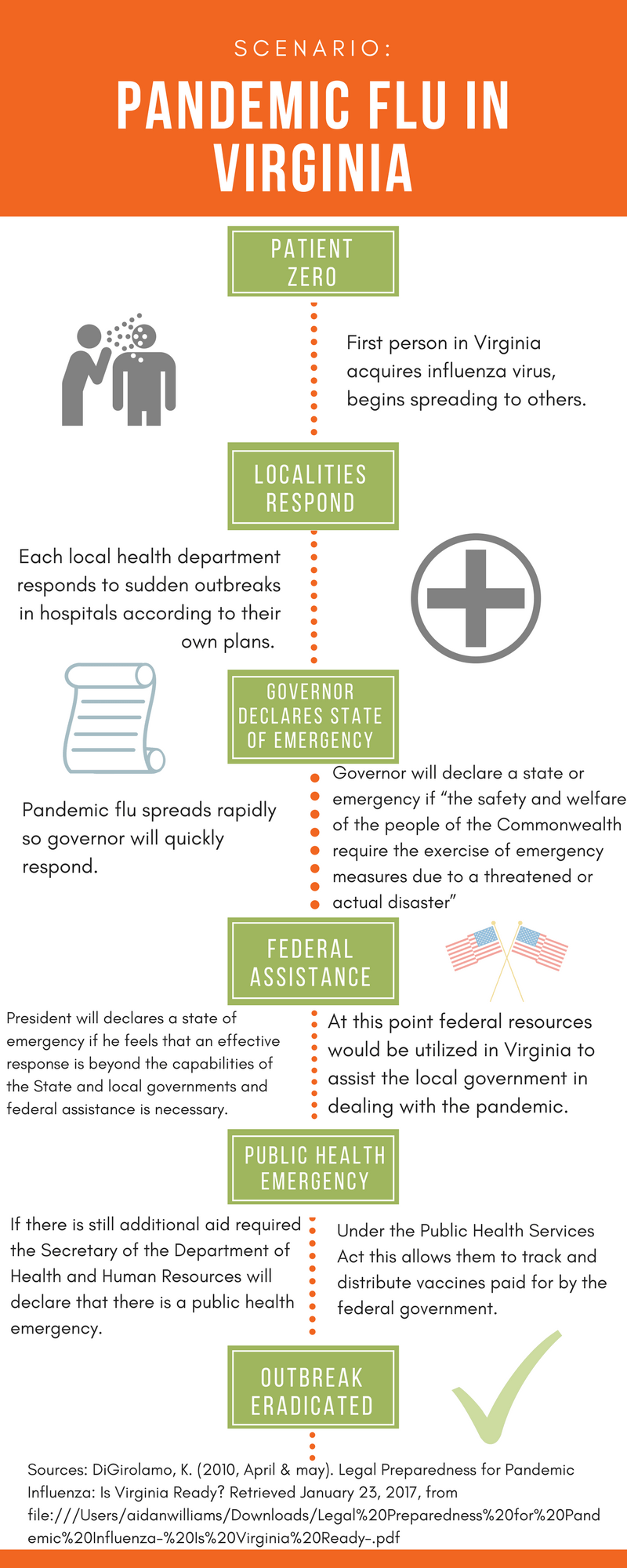Scarce Resource Allocation
Outline
I. Introduction
II. Major Mistakes of 1918 Flu Pandemic
III. Policies about Allocation of Resources
I. Introduction
Resources can be defined as any good or service with limited availability. In the case of flu pandemic, scarce medical resources could potentially entail food, water, vaccines, hospital beds, first responders, ambulances, or medical workers. There are currently no federal laws that explicitly define a plan for scarce resource allocation during such a crisis, leaving each state the jurisdiction to create it’s own preparedness plan. On this page we will first look at some government agencies and legislature that lay out guidelines and protocols for how each level of government should handle scarce resource allocation. We will then discuss the stakeholders involved in the process of resource allocation, and the possible legal issues that may arise during a resource shortage. Finally, we will examine the current U.S. approach for allocation of scarce resources, look at other methods that could potentially be incorporated into our current plan, and discuss the pros and cons of each.
II. Major Mistakes of 1918 Flu Pandemic
- Due to involvement in WWI, the federal government ignored and denied the seriousness of the pandemic in order to keep focus on war effort. Newspapers were even banned from printing anything about the pandemic that would alarm readers (Billings).
- The general public was aware of how serious the situation actually was, which created distrust of the government and media, which eventually sparked fear and chaos.
- Medical advice on containment was ignored by governing officials.
- Agencies tasked with the containment did not coordinate their efforts.
- Social distancing was not utilized in any way to control the spread of the disease (Billings).

The authorities whom hold legal power in an emergency and what agencies regulates the power. Infographic made by Ailen using Piktochart.

The definitions of specific government organizations and acts that would be involved with the distribution of resources. Infographic made by Jessica using Canva.
III. Policies about Allocation of Resources

This chart gives an example of how an epidemic would be treated in the state of Virginia with step by step play though. Infographic made by Aidan using Piktochart.
Allocation of resources are different at the local, state, and national level. To understand how each level interplays with one another, a hypothetical flu pandemic situation is shown in the infographic to the right.
There are currently no federal or state laws that explicitly outline preparedness plans for scarce medical resource allocation, meaning each state has jurisdiction over their own preparedness plans for distributing medical resources (Garcia-Santillan, 2017). Because each level has its own responsibility to create a plan, there is an opening for confusion about who get the resources and when like vaccines during a flu pandemic.
“Part of the legal preparedness for a possible declaration of a state emergency must be a plan for the integration of federal resources into the state’s preexisting response plan” (DiGirolamo, 2010).
This is yet to be seen in every state; however, the federal government has created NIMS in an effort to decrease the amount of confusion. Thus “volunteers will be able to travel from one locality to another without having to learn a new system for providing help and requesting resources” (DiGirolamo, 2017). This in turn will allow for the distribution of resources in a timely manner, which could increase the distribution of vaccines.
There are also organizations like the CDC and the NIH who have made suggestions and guidelines of what the nation on a state and local level ought to do during a pandemic. For example, the CDC suggests that the “prioritization of resources should be based on ‘preserving the functioning of society’ and that ‘[t]hose individuals who are essential to the provision of health care, public safety and the functioning of key aspects of society should receive priority in the distribution of vaccine, antivirals and other scarce resources’” (Williams, 2017).
Whatever plan is decided on,
“It is essential that all the legal and policy information related to the containment of a pandemic is transparent and well known, or we are headed for a catastrophe that could have been prevented by honesty and simple planning” (Hooven, 2017).

Each of these allocation frameworks have advantages and disadvantages. Some of the advantages and disadvantages and some examples of their implementation are located here. Not one of these principles on its own can correctly and fairly solve the problem of resource allocation. However bringing together some if not all of the principles together to form a “multi principal allocation systems can higher the chances of fairness. Infographic made by AJ using Piktochart.
About the Authors
Aidan, Ailen, Aj, Miriam, Jessica and Travis are current students at James Madison University. Aiden and Travis are both ISAT majors with a biotechnology concentration while Ailen, Aj, Miriam, and Jessica are biotechnology majors. This collaboration was due to an assigned project in Ethical, Legal, and Social Implication of Biotechnology class. The content in this webpage may or may not reflect each individuals views on the topics.
Resources
Who we are, what we do. (n.d.). Retrieved January 31, 2017, from http://www.who.int/about/en/
Cornell, Jessica, Et al. (2017, January). Unpublished Essays submitted for spring ISAT 456
About NIH. (n.d.). Retrieved January 31, 2017, from https://www.nih.gov/about-nih
Recent Outbreaks and Incidents. (2016, June 09). Retrieved January 31, 2017, from https://emergency.cdc.gov/recentincidents/index.asp
Atabong, Ajongako (2017, January). Allocation of resources in the US in case of a medical emergency. Unpublished Essay submitted to ISAT 456.
Garcia, Ailen (2017, January). Legal Preparedness for Scare Resource Allocation in Public Health Emergencies. Unpublished essay submitted to ISAT 456 spring 2017.
Garcia, Ailen (2017, January). [Government Officials with most legal power and corresponding legal powers]. Made with Piktochart (https://magic.piktochart.com/output/19880623-government-officials-legal-powers-for-resource-allocation).
DiGirolamo, Kristen, 13 Rich. J. L. & Pub. Int. 385. (2010). Comment, Legal Preparedness for Pandemic Influenza: Is Virginia Ready?, pp. 385-407.
Persad, G., Wertheimer, A., & Emanuel, E. J. (2009). Principles for allocation of scarce medical interventions. The Lancet,373(9661), 423-431. doi:10.1016/s0140-6736(09)60137-9
Williams, Aidan. (2017, Janurary). Legal Aspects of Scarce Resource Allocation. Unpublished Essay submitted to ISAT 456.
Billings, M. (1997, June). The Influenza Pandemic of 1918. Retrieved from https://virus.stanford.edu/uda/.
